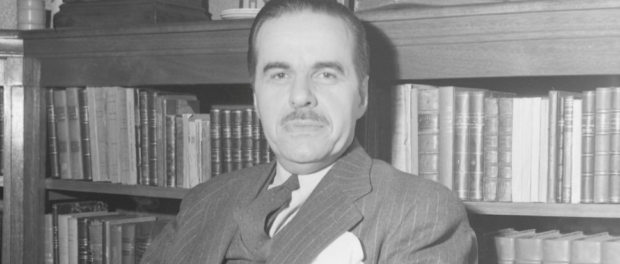1934: Paul Gouin & Other Quebec Curios
Part of “Shadows and Revolution”, 1900-1960
 Paul Gouin, c. 1945, photographed by Conrad Poirier. Photograph courtesy of the Bibliothèque et Archives nationales du Québec/P48,S1,P12381
Paul Gouin, c. 1945, photographed by Conrad Poirier. Photograph courtesy of the Bibliothèque et Archives nationales du Québec/P48,S1,P12381
Up-and-coming politician Paul Gouin would also follow in the footsteps of his family. The grandson of Honoré Mercier and the son of Lomer Gouin, the young Paul Gouin would have not one but two politicians—and Premiers—to look up to in his family. Like others of his generation, he was impacted by the First World War, serving overseas in England. Gouin, however, was a lawyer by trade, educated at the Université Laval and the Université de Montréal in law and admitted to the bar in 1920. Initially working in various small firms, he also had a side business in publishing, which would serve him well in the future. Yet it was politics, like Duplessis, was in Paul Gouin’s blood, and he soon looked into the Liberal Party as his party of choice but left disillusioned.
Gouin would realise that he wasn’t alone with his disillusionment. He and the other younger members of the Liberal Party were disappointed with the leadership of Louis-Alexandre Taschereau, a man who they saw in league with big business instead of the people and who they perceived to have been a failure during the Great Depression, encouraging the development of private businesses instead of creating measures to help Québec’s citizens. In this vein, Gouin would found Action libérale nationale, a party dedicated to nationalism, farmer’s accessibility to credit, and nationalisation of electricity (particularly hydroelectricity). Gouin, a follower of Abbé Lionel Groulx’s social and political thought, used his publishing business to start up a newspaper, La Province, to write about and spread the policies of the new political party around the province.
By the time the Action libérale nationale was up and running, it was almost time for the next elections. Maurice Duplessis was the only other opposition to Gouin, but both wanted Taschereau to have a taste of what a real opposition might look like. It was in this light that Gouin and Duplessis decided to unite their efforts just prior to the 1935 election, agreeing that only one candidate of either the Action libérale nationale or the Conservative party would run in one given district, making any given district an only two-candidate race. This ploy only partially worked in Duplessis and Gouin’s favour: Taschereau got re-elected, but it was not without gains for the other two parties. Not only did Duplessis gain six seats in the Legislative Assembly (a total of seventeen seats), Gouin’s new party also gained twenty-five seats. Together, Duplessis and Gouin had forty-two seats, forming a powerful coalition and a strong voice against Taschereau’s forty-seven seats.
Taschereau’s days were numbered as Premier of Québec, and one scandal would bring his government down not long after this election. Duplessis and Gouin, however, once their goal had been achieved, would sit uneasily with each other in the meanwhile. Only one of them could be the next Premier.





